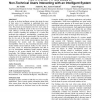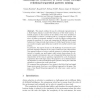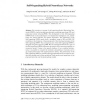2082 search results - page 369 / 417 » Using model knowledge for learning inverse dynamics |
CHI
2007
ACM
14 years 9 months ago
2007
ACM
In order to develop intelligent systems that attain the trust of their users, it is important to understand how users perceive such systems and develop those perceptions over time...
CORR
2010
Springer
13 years 5 months ago
2010
Springer
This report outlines the use of a relational representation in a Multi-Agent domain to model the behaviour of the whole system. A desired property in this systems is the ability of...
KI
2006
Springer
13 years 8 months ago
2006
Springer
Abstract. Several options are available to relate agent logics to computational agent systems. Among others, one can try to find useful executable fragments of an agent logic or us...
ICCS
2003
Springer
14 years 1 months ago
2003
Springer
Abstract. We introduce a concept of self-organizing Hybrid Neurofuzzy Networks (HNFN), a hybrid modeling architecture combining neurofuzzy (NF) and polynomial neural networks(PNN)....
ICRA
2008
IEEE
14 years 3 months ago
2008
IEEE
For complex robotic tasks (manipulation, locomotion, haptics, ...), the lack of knowledge of precise interaction models, the difficulties to precisely measure the task associated ...



